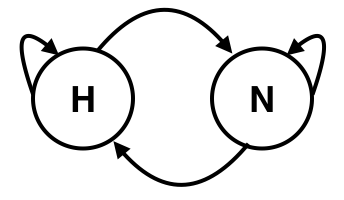Markov Migraine
subtitle: This is what I think about during my 20-mile commute (plus traffic)
I had been thinking of my headaches as modeled by a fairly simple Markov chain. There would be the headache state and the not-headache state. The transition probabilities would be such that they described my experience: Once I get a headache, I tend to have them every day for several days in a row. But when I get out of the headache state, I can have a lot of headache-free days in a row. Now that I’ve been taking the amazing (off label) medication, I can go two weeks without a headache.

But over the past few days I’ve come to think that the model isn’t perfect. I’d been in the headache state for roughly 10 days, which is the sort of thing that causes me to think about my headaches a lot more. I had seven days with headaches during that 10-day span, but even on the three days without headaches, I really felt like I was still in the headache state (even though I didn’t have a headache). My model didn’t take into account that the probability of having a headache would be yet another variable to include in the model.
So then I was thinking each state would also have a headache probability. So I would have a two-state model, a stepping rule (roll the dice every day), and a headache parameter for each state.
An aside here: For years I’ve been questioning the cause and effect of my migraine “triggers.” That is going to inform the next iteration of my model. For a really long time I knew that if I saw an intense source of light—the sun glinting off the chrome trim of a car—that I would get a headache. But then I later came to realize that I could see the same car under the same conditions, but sometimes that reflected sun beam would not be quite so bright or quite so painful. I’ve come to believe that when my brain is in a migrainous state, then the way that I perceive bright reflections is different. Does the bright light help bring on the headache faster? Maybe. But I think that the brightness in my perception is driven by a migraine process that is already at work. Likewise, I think that strong smells bother me more when I’m in a migrainous state; it’s not necessarily the smells bringing on the migraine.
I’m rethinking my model entirely. Why have two discrete states that each have a probability attached to them? Why not have one state with a headache probability parameter and then define the rules that affect that parameter. (Aside: it’s not like any of these models are going to be useful for anything other than giving me a system or framework to think about my headaches. None of my neurologists care about my construction of a headache time series analysis).
So now I am back to a more sophisticated version of my very old model that assumed that every migraine trigger had a fixed number of points and that if your score exceeded a certain number, then you would get a headache. The current model has a continuous parameter. I think that the value of the amazing new (off label) medicine is that it makes it harder for the headache parameter to increase. If I’m in a non-headache state, then I’m much less likely to have headaches. I see this in my data with much longer streaks of headache-free days. I don’t have a good sense of what it could do in terms of lowering the parameter. When the parameter is high, I think that I can get caught in feedback loops.
I guess this will give me a new collection of journal articles to read.